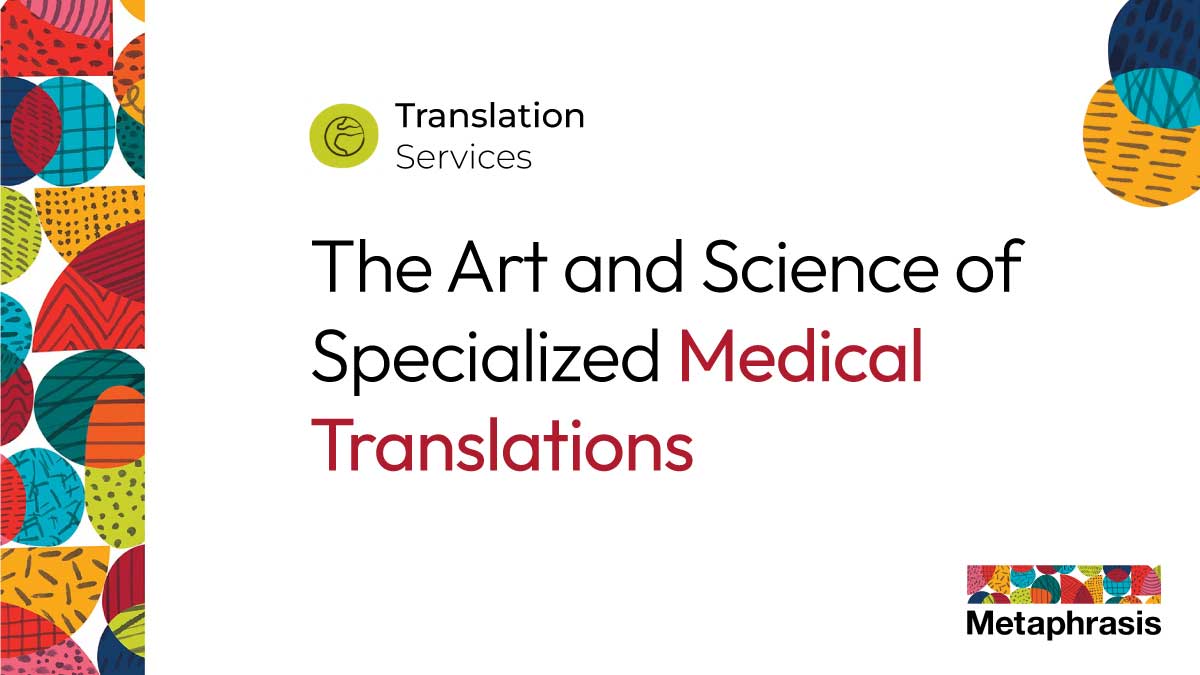
Beyond the Basics: The Art and Science of Specialized Medical Translations
In today’s interconnected world of healthcare, accurate translation of medical documents goes far beyond words—it’s a matter of safety, trust, and care. From patient records and consent forms to drug labels and clinical research, every detail must be precise. Medical translation requires more than fluency in multiple languages; it demands deep subject-matter knowledge, cultural understanding, and an unwavering commitment to accuracy.
At Metaphrasis, we understand that the right translation can make all the difference in how care is delivered, understood, and received.
Why Medical Translation Is Exceptionally Complex
Medical documents are rich with technical terminology, abbreviations, and field-specific context. Unlike general translations, even a minor error here can have serious consequences—impacting diagnosis, treatment, or compliance. The stakes are high, and precision is non-negotiable.
Key Challenges in Medical Translation
Terminology Consistency
Medical language leaves no room for ambiguity. Translators must ensure that every term is used consistently across all materials—from drug labels and clinical trial protocols to patient information leaflets. To achieve this, professionals rely on carefully maintained terminology databases and standardized glossaries.
Cultural and Legal Sensitivity
Healthcare communication extends beyond accuracy—it must also be empathetic and culturally appropriate. Translators must ensure that consent forms, patient instructions, and educational materials are not only clear but also sensitive to cultural expectations and compliant with local healthcare laws.
Abbreviations and Acronyms
Documents often include abbreviations such as BP (blood pressure) or Rx (prescription). Translators carefully determine when to translate, expand, or retain these terms, depending on the audience and context, to preserve clarity and understanding.
Handwritten and Poorly Structured Texts
Medical records frequently include handwritten notes or irregular formatting. Translators must interpret these thoughtfully, sometimes collaborating with healthcare professionals to confirm meaning and ensure that critical information is conveyed correctly.
Multilingual Regulatory Requirements
Pharmaceutical and clinical documentation must meet the requirements of various regulatory agencies, such as the FDA, EMA, or PMDA. Translators must be well-versed in these standards, ensuring that the language and format meet every jurisdiction’s expectations.

How Professional Medical Translators Overcome These Challenges
Specialized Training and Certification
Professional medical translators often hold advanced certifications—such as the ATA Medical Translation Certification—or have formal backgrounds in healthcare, life sciences, or pharmaceuticals. Their training allows them to understand not only the language but the science behind the text, ensuring that each translation is both accurate and contextually sound.
Collaboration with Medical Experts
Medical translation is rarely a solo effort. Translators frequently work with physicians, pharmacists, and researchers to verify terminology or clarify nuances in complex materials, such as clinical trial documentation or medical device instructions. This collaborative approach ensures accuracy and integrity in every translation.
Use of Translation Memory and CAT Tools
Consistency is essential, especially in large projects. Translators use computer-assisted translation (CAT) tools and Translation Management Systems (TMS) to streamline workflows. These technologies maintain translation memory, term bases, and style guides—allowing for efficient updates to patient records, drug labels, or research documents while preserving quality and precision.
Rigorous Quality Assurance
Every translation undergoes multiple layers of review, including editing, proofreading, and subject-matter validation. At Metaphrasis, our Quality Assurance process includes structured checkpoints at every stage, ensuring linguistic precision, regulatory compliance, and adherence to each client’s unique standards.
Adherence to Ethical and Compliance Standards
Confidentiality is a cornerstone of medical translation. Protecting patient data is as critical as ensuring translation accuracy. At Metaphrasis, all linguists and support staff complete HIPAA certification and annual security awareness training. This ensures full compliance with federal privacy regulations and guarantees that Protected Health Information (PHI) remains secure at all times.
Choosing the Right Translation Partner
Medical document translation is both an art and a science—where empathy meets expertise. It’s not just about language, but about ensuring that every word supports patient safety, regulatory compliance, and the integrity of healthcare communication.
Selecting the right translation partner means choosing a team that values precision, compassion, and professionalism in equal measure.
At Metaphrasis, we approach every medical translation project with care and commitment—bridging language barriers so that healthcare providers and patients can communicate clearly, confidently, and safely.
